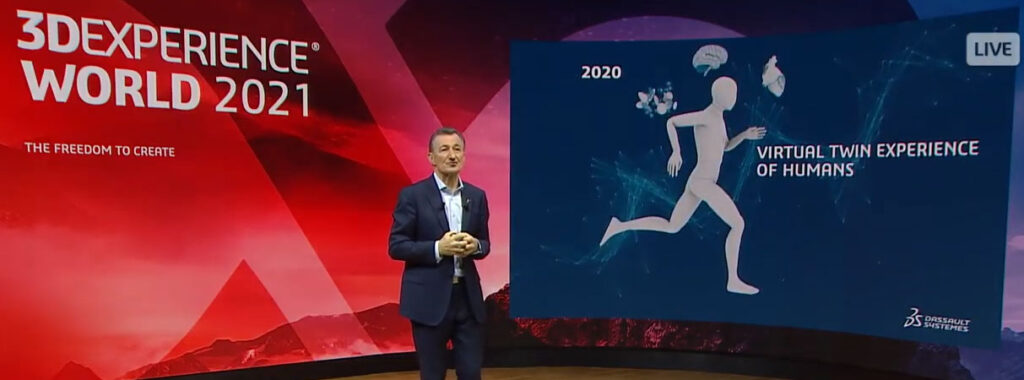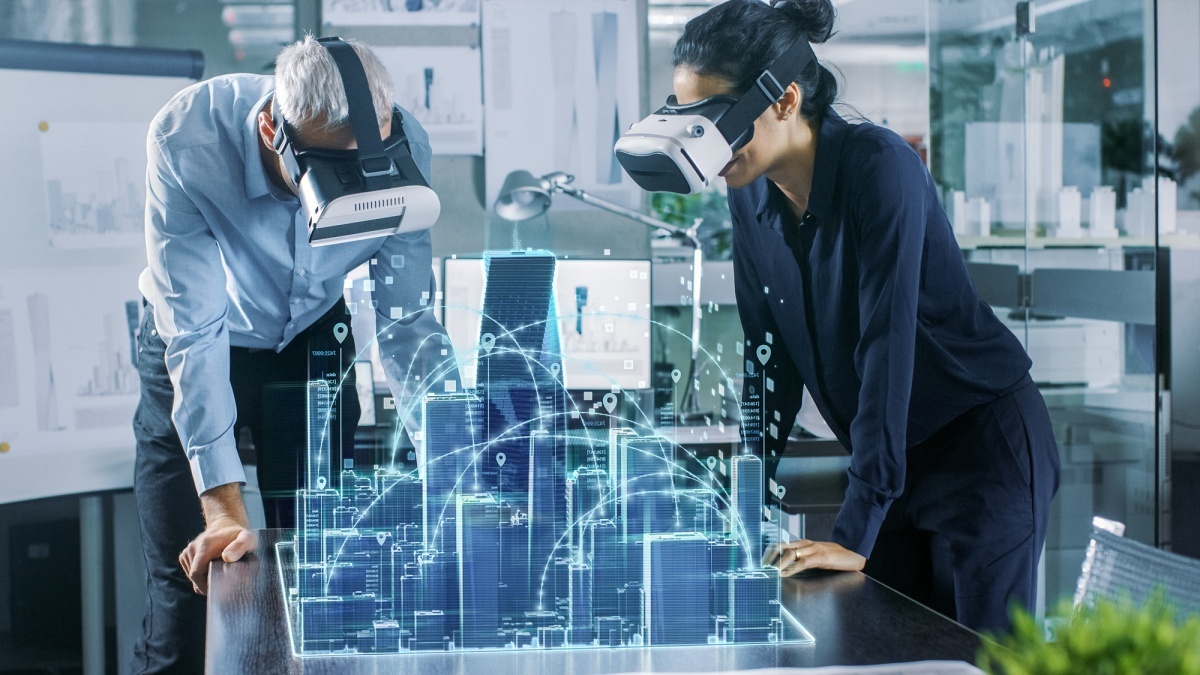Dassault Systèmes is building the platforms of the Industrial Metaverse by working in a different way than the one envisioned by Mark Zuckerberg to design the platforms of the future
Perhaps the perspective with which we are all looking at the metaverse, i.e. a “virtual place where billions of people will find themselves doing everything they do in real life“, is completely wrong. Perhaps the perspective brought forward above all by Mark Zuckerberg, who reorganized his company and the flow of mainstream conversation around a parallel world concept made for avatars that will allow us to live the life we want, is misleading or at least limited. In short, it is only one of the possible metaverses.
Let’s take the example of Dassault Systèmes, which is working with a certain determination on the integration and consolidation of all its tools in various sectors, from design to engineering, from manufacturing to tools for monitoring via IOT, in a single all-encompassing platform. It is not the only company that is working on this perspective: its competitors in the PLM (Product Lifecycle Management) sector such as Siemens, PTC and Bentley are also operating in this way. They are all focusing on streamlining workflows within digital work tools which are each part of their own platform. The goal is simplify workflows between different tools, integrating the various components vertically as well as horizontallyto eliminate friction between components, making the creation process increasingly fluid within the various sectors.
Connect people, ideas, data and solutions in one collaborative environment
At this stage the integration of tools from a single vendor, Dassault Systèmes or even others, does not fully support interoperability with competitive tools. But it is also this is the probable fate of platforms such as Dassault Systèmes’ 3DEXPERIENCE Platform: connect people, ideas, data and solutions in a single collaborative environment which enables the untapped potential of large companies as well as small startups, SMEs and individual creative-entrepreneurs and designers.
«The platform – he says Gian Paolo Bassi, Senior Vice President of 3DExperience Works in Dassault Systemes – allows you to do many things: we have extended the concept of simulation to all phases of the project. It is possible to do virtualization of tests and tests on materials to demonstrate that a component is functional even before making the prototype, anticipating times and tests, which require long and expensive tests for validation».
An approach of this type has many consequences, not least the instinctive resistance of many SMEs:
«For small and medium-sized Italian companies – continues Bassi – using something that has never been tested before can be a source of concern, but in reality we need to understand that the simulation is 360 degrees, not just under stress. And it allows simulate production processes, factory ergonomics with virtualized workers who move around carrying materials, how heavy these materials are and how long they must be moved, warehouse management and so on”.
It is a historical passage. The direction is that of building large platforms, which allow you to completely reimagine the deepest workflow, not just that of design, in a completely different way from what we have seen up to now. And the name, as explained by the Chairman of the Board and CEO of Dassault Systèmes, Bernard Charlés, during the 3DExperience World Conference which was again held in person in Nashville, in the US state of Tennessee, is that of “Industrial Metaverse“.

For once, the strategic choice of the name given to a project objective is not simply a marketing slogan that eavesdrops on a keyword of the moment, such as Zuckerberg’s Metaverse, but a declaration of principle that espouses a precise idea. The metaverse is not so much a place to play and trade to the public, a kind of Second Life crossed with Minecraft. The metaverse is not, in short, a place.
Instead, Dassault Systems created a platform with more than six million designers, students, entrepreneurs and makers working on the creation of physical products using the Solidworks ecosystem. The company is transforming software packages, merging the data silos of dozens of internal tools, and changing the code to make them fully interoperable. Furthermore, is bringing everything to the cloud, opening its data centers to provide processing capacity and information storage, and introducing a new licensing model.
Collaboration management, data management, mobility and security “by design” of the platform according to Dassault Systèmes should make it possible to remove many of the obstacles and frictions to the use of this type of tool by millions of other users, simplifying life especially on the side of creativity and adding theartificial intelligence not as a standalone generative tool but as an aid and support for the realization of repetitive and obvious passages in the work.
At the heart is the concept of Virtual Twin, the virtual digital twinMeaning what the technological experience around which the work of consolidating and reorganizing the conception, planning, design, construction, maintenance and management of the supply chain revolves. A way to use the tools with the aim of taking and rearranging the “pieces” that make up the various phases.
The discourse seen so far is necessarily generic and abstract, because revolves around heterogeneous software components but also completely different production sectors: from the design, construction and maintenance of airliners to that of automobiles, from the production of engineering structures to robotic hands. The commercial horizon of Dassault Systèmes’ products (and of some of its competitors) is so broad that there would be more exceptions to raise than points of contact between the various sectors.
And yet, a single synthesis and governance of this complexity of instruments is more than possible.
«We are number one – explains Bernard Charlés – in software tools for the production of aircraft, tablets, robots, furniture, boats, but also products for health, medicine, life sciences, infrastructures and smart cities, not to mention that 35% of world GDP is given by manufacturing, 15% by life sciences and 45% by infrastructure and energy».
Dassault Systèmes’ solutions based on Virtual Twin technology thus extend from manufacturing to construction, energy, consumer goods, healthcare and other sectors. The company also sees a large number of small and medium-sized enterprises with a strong demand for digital technology that can very quickly open the doors to this type of tool, because it is necessary for the digital transformation of one’s activities or tools necessary to get started, in the case of new startups especially in the manufacturing sector in Europe as in the USA.
The paradigm shift underway, i.e. the one that is taking place in the tools for the creation, design, development and management of the life cycle of these “physical objects”, is therefore oriented around the idea of the Industrial Metaverse. But this label conflicts with the idea of a “Zuckerberg-style” metaverse and with what is routinely presented in the press. Or not? It is necessary to delve into the perspective of the metaverse idea itself and change the point of view.
That’s what various analysts and one thinker in particular, Tim O’Reilly, are doing. The Irish-born American editor has been compared to Denis Diderot or Jean-Baptiste d’Alembert. Because every revolution, starting with the French one, must have an editor who contributes to disseminating the ideas of intellectuals with his encyclopedia of the case.
For O’Reilly Media, which began with Unix user manuals in the early 1980s, the publishing business has provided the books that have guided three generations of digital creators through the stages of the great transformation that began with the ‘personal computing continued with the internet, the web, the cloud, big data, AI and open source (a term that popularized O’Reilly himself), to name just a few. Thanks to O’Reilly also the diffusion of the idea of Web 2.0, of the “Internet Operating System” or of the “Government as a platform”.
In these weeks O’Reilly plays with an idea: the one according to which “the Metaverse is not a place“.
The concept is simple:
«The metaphors we use to describe new technologies – says O’Reilly – condition the way we consider them and, like an obsolete map, often lead us astray. So it is with the metaverse. Some seem to think of it as a kind of real estate, complete with land grabbing and trying to drive traffic to whatever piece of virtual property they’ve created. The metaverse as the successor to Second Life and the Web, social media feeds and the idea of sites as places to visit. Instead, what if we think of the metaverse as a means of communication?».
«If we use the metaverse metaphor as “communications medium” – says O’Reilly -, we see it as a continuation of the tools we already use, starting from messaging, emails, social meetings, apps such as Zoom, Google Meet, Teams and those for broadcasting such as Twitch and Discord. A mediator for interactions that are not based on a “place” but that occur in the ether, between two or more connected people. The occasion then is more of a point than a place».
This idea of the metaverse not as a virtual placenot as a spatial metaphor, but as a tool for connectivity and which makes it possible to bring together communication flows between people physically located in different areas and times, but who are in contact both through the exchange of messages in real time (for example a videocall ) and register (an email or a message already sent), it opens the door to a more complex and social reality.
A reality that also includes – but not exclusively – the expensive and complex 3D tools, glasses and viewers used for the operational visualization of the Virtual Twins. Basically, using this metaphor, “to be” in the metaverse means to be part of a flow of communicationas happens with emails, messages and phone calls, which no one imagines as “places” but as forms of distance relationship mediated by different and often not very immersive IT devices.
Here the profound digital transformation that integrated PLM platforms such as the one that Dassault Systèmes is building is better explained and understood (even by those who are creating it) by changing the point of view, i.e. changing the metaphor.
What Dassault Systèmes and others are building are not places. Instead, they are ways that allow us to do things together differently, removing the friction in ideation and design activities, providing more powerful tools with a loop and faster feedback to those who have to think of things and try to make them to see if they workand then get in touch with the rest of the supply chain to produce them and make them sustainable as well as safe and operational.
If the Industrial Metaverse is actually going to take rootthis will not happen because it is a virtual place where millions of creatives and makers can be found. Instead, it will be because it’s a conversation you can join.
breaking latest news © (Article protected by copyright)
